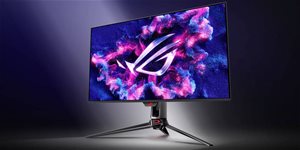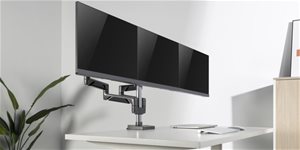What to look for when choosing an office monitor
How often will you use the monitor?
- For occasional usage, a monitor with a diagonal of at least 19" will suffice.
- For regular use, we recommend a monitor with a diagonal of at least 22". For convenience, select a model with an adjustable height and technologies to minimize eye fatigue (Flicker-free, Flicker-safe, etc.).
If you are buying two monitors for one computer, we recommend selecting the same models to avoid differences in colour reproduction.
Resolution
The larger the monitor you choose, the higher the resolution should be. With a higher resolution, you get a more detailed picture and a larger workspace.
| Screen Size (1" = 2.54cm) | 20" | 21-32" | 33" and larger |
| Resolution needed to ensure adequate image quality | XGA (1024 x 768 pixels) or higher | Full HD (1920 × 1080 pixels) or higher | UHD or 4K (3840 × 2160 pixels) or higher |
Panel Type
- IPS/S-IPS monitors - excel in natural colours, low power consumption and wide viewing angles. The disadvantage is a higher purchase price.
- TN monitors - often characterised by low response times. Compared with IPS monitors they are cheaper, offer lower-quality colour reproduction and narrower viewing angles. While cheaper TN monitors are sufficient for less demanding users, models with 4ms response times are popular with gamers.
- MVA/PVA monitors - in terms of price and picture quality, these are somewhere between IPS/S-IPS and TN monitors. They provide more realistic colour reproduction and wider viewing angles than TN monitors and are cheaper than IPS monitors.
Screen Surface
- Matte - reflects light from surroundings; provides less-saturated colour reproduction.
- Glossy - provides vibrant and realistic colours but more ambient light is reflected, so the display can be hard to see in bright sunlight.
- Anti-glare - a compromise between glossy and matte screens; they are easier to view in direct sunlight than glossy screens but offer lower quality colour reproduction.
Connectors
Before buying, make sure the monitor has at the least one compatible port with your computer. If not, you won't be able to connect the monitor to it.

Useful Functions and Features
- Eyestrain-minimising technology - Flicker-free, Flicker-safe, etc.
- Adjustable height - allows you to adjust the monitor to a comfortable position.
- TV tuner - for watching television broadcasts.
- VESA mount - allows you to mount the monitor on a bracket.
- Web camera - useful if you plan to make calls over the Internet.
- USB Hub - play data from portable drives; connect a keyboard or mouse.
- Pivot - allows the screen to rotate horizontally; suitable for office work and reading texts from your computer.
Hide description
 Home Office
Home Office
 Ergonomic
Ergonomic
 With TV Tuner
With TV Tuner
 Curved
Curved
 Graphic Design and Photography
Graphic Design and Photography


































